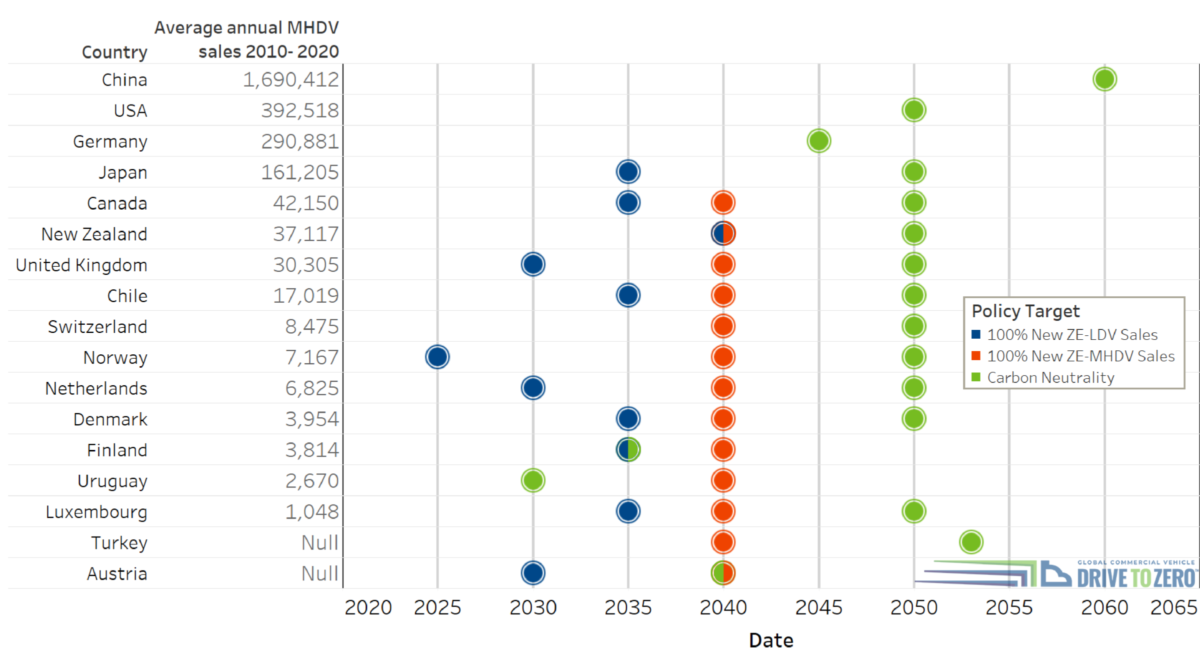PASADENA, Calif. – Top nations will fall short of ambitions to reach net-zero carbon emissions by 2050 if they fail to address the emissions created by the medium- and heavy-duty vehicle (MHDV) sector according to a new briefing paper from CALSTART’s Global Commercial Vehicle Drive to Zero program and campaign (Drive to ZeroTM). Review of Commitments for Zero-Emission Medium- and Heavy-Duty Vehicles, highlights the current ambitions of leading nations and original equipment manufacturers (OEMs) to address the growing emissions from the MHDV sector and move toward zero-emission technologies – creating a feasible pathway toward net-zero by 2050.
“Globally, freight trucks and buses represent about 4% of the on-road fleet but are responsible for approximately 36% of on-road fuel consumption and respective GHG emissions. Given how disproportionately these vehicles impact our environment and air quality, nations must address this critical sector if they hope to reach net-zero by 2050,” said Dr. Cristiano Façanha, CALSTART’s Global Director and lead of Drive to Zero.
Countries’ policy targets for on-road vehicles

Note: Countries arranged in descending order by average annual MHDV sales from 2010 – 2020; Data unavailable for Turkey and Austria. LDV = light-duty vehicles; MHDV = Medium- and heavy-duty vehicles.
The paper finds that only 15 countries have a clear end date for sales of polluting trucks and buses. These countries – Austria, Canada, Chile, Denmark, Finland, Luxembourg, Netherlands, New Zealand, Norway, Scotland, Switzerland, Turkey, United Kingdom, Uruguay and Wales – signed onto the Global Memorandum of Understanding on Zero-Emission Trucks and Buses (MOU) announced at COP26. Under the MOU, the nations agree to work together toward 100% zero-emission new truck and bus sales by 2040 with an interim goal of 30% zero-emission new vehicle sales by 2030. In a coordinated effort, top manufacturers and fleets like Scania, DHL, and Heineken are endorsing the MOU and agreeing to work collaboratively toward the same 2030 and 2040 goals.
It is notable that leading nations like the United States, China, Germany, and Japan all have significantly larger fleets than the countries included in the MOU. In fact, those four leading nations together account for 67% of new MHDV sales globally in 2019. “Many countries have primarily set their focus on passenger vehicles and light-duty transportation. From an emissions perspective, these nations must address both cars as well as trucks and buses if they hope to reach net-zero by 2050,” said Dr. Façanha.
As a companion piece, Drive to Zero is also publicly unveiling its new Progress Dashboard. The Dashboard compiles, highlights and describes the MHDV policy development taking place in leading regions around the world. The new tool also specifically tracks the policy progress being made by all signatories of the Global MOU.
“Nations need to adopt these policies to meet their ZEV sales targets. They are enabling best practices to be shared and are – through the MOU – committing to coordinate actions with the aim of speeding zero-emission MHDV uptake and deployment,” said Owen MacDonnell, Associate Project Manager for CALSTART who led the creation of the Dashboard. The Dashboard will be updated regularly to capture new ZE-MHDV policies adopted globally and to feature new nations.
“Target-setting should be considered a foundational step in developing a supportive suite of policies that will catalyze the major transformation needed in the transport sector,” said Dr. Façanha. “In addition to setting ambitious sales targets, nations that want to reach net-zero carbon emissions by 2050 must also adopt strong regulations, establish targeted and timebound incentive programs, and increase infrastructure investments.”
The new paper notes that in addition to government commitments, over the past few years, MHDV manufacturers have quickly ramped up their own commitments to zero-emission vehicles. This alignment between leading countries and OEMs will help advance and accelerate the deployment of ZE-MHDVs.
CALSTART | Changing transportation for good
A national nonprofit consortium with offices in New York, Michigan, Colorado and California and partners world-wide, CALSTART works with nearly 300 member company and agency innovators to build a prosperous, efficient and clean high-tech transportation industry. We knock out barriers to modernization and the adoption of clean vehicles. CALSTART is changing transportation for good.
To align government and industry actions and ambition, the Drive to Zero program and campaign enjoys the support from top manufacturers, fleets, governments, and infrastructure providers.
Contact: Roxanna Smith | Roxanna.Smith@globaldrivetozero.org | 510-326-0390
